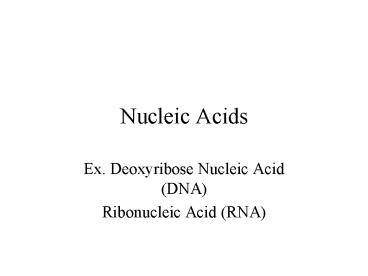Nucleic Acids - PowerPoint PPT Presentation
1 / 35
Title:
Nucleic Acids
Description:
Nucleic Acids Ex. Deoxyribose Nucleic Acid (DNA) Ribonucleic Acid (RNA) Nucleic Acids Polymers DNA RNA (tRNA, mRNA, rRNA) The nitrogenous bases (A, C, G, T) are what ... – PowerPoint PPT presentation
Number of Views:60
Avg rating:3.0/5.0
Title: Nucleic Acids
1
Nucleic Acids
- Ex. Deoxyribose Nucleic Acid (DNA)
- Ribonucleic Acid (RNA)
2
Nucleic Acids
- Nucleic Acids
- Informational Polymers Code for all of the
proteins in an organism - Monomers Nucleotides
- Each Nucleotide is made up of
- 1) Phosphate Group
- 2) Pentose 5-C Sugar
- Ribose or deoxyribose
- 3) Nitrogenous bases
- Adenine (A), Cytosine(C), Thymine (T),
Guanine(G), and Uracil (U)
3
Nucleic Acids
- Polymers
- DNA
- RNA (tRNA, mRNA, rRNA)
- The nitrogenous bases (A, C, G, T) are what makes
up the DNA code - RNA codes are transcribed or made from DNA codes
- Proteins are then translated or made from RNA
codes
4
Scientists call this the
DNA
DNA
Central Dogma of Molecular Biology!
RNA
RNA
Protein
Protein
5
How do we know that all of our genetic
information comes from DNA?
- What type of experiment would you design to
determine that DNA is the source of all genetic
information?
6
Griffiths Experiment with Pneumonia and the
accidental discovery of Transformation
- Frederick Griffiths was a bacteriologist studying
pneumonia - He discovered two types of bacteria
- Smooth colonies
- Rough colonies
CONCLUSION The smooth colonies must carry the
disease!
7
Griffiths Experiment with Pneumonia and the
accidental discovery of Transformation
- When heat was applied to the deadly smooth type
- And injected into a mouse
- The mouse lived!
8
Griffiths Experiment with Pneumonia and the
accidental discovery of Transformation
- Griffith injected the heat-killed type and the
non-deadly rough type of bacteria. - The bacteria transformed itself from the heated
non-deadly type to the deadly type.
9
Griffiths Experiment did not prove that DNA was
responsible for transformation
- How would you design an experiment to prove that
DNA was responsible for transformation?
10
Avery, McCarty, and MacLeodRepeated Griffiths
Experiment
Oswald Avery
Maclyn McCarty
Colin MacLeod
11
Avery, McCarty, and MacLeodAdded the non-deadly
Rough Type of Bacteria to the Heat-Killed Smooth
Type
To the Heat-Killed Smooth Type, added enzymes
that destroyed
Carbohydrates
Lipids
Proteins
RNA
DNA
12
S-Type Carbohydrates Destroyed
S-Type Lipids Destroyed
S-Type Proteins Destroyed
S-Type RNA Destroyed
S-Type DNA Destroyed
Conclusion DNA was the transforming factor!
13
The Hershey-Chase Experiment
Protein coat
- Alfred Hershey Martha Chase worked with a
bacteriophage - A virus that invades bacteria. It consists of a
DNA core and a protein coat
DNA
14
Protein coats of bacteriophages labeled with
Sulfur-35
Phage
- Hershey and Chase mixed the radioactively-labeled
viruses with the bacteria
Bacterium
Phage
The viruses infect the bacterial cells.
Bacterium
DNA of bacteriophages labeled with Phosphorus-32
15
Protein coats of bacteriophages labeled with
Sulfur-35
- Separated the viruses from the bacteria by
agitating the virus-bacteria mixture in a blender
DNA of bacteriophages labeled with Phosphorus-32
16
Protein coats of bacteriophages labeled with
Sulfur-35
- Centrifuged the mixture so that the bacteria
would form a pellet at the bottom of the test tube
- Measured the radioactivity in the pellet and in
the liquid
DNA of bacteriophages labeled with Phosphorus-32
17
The Hershey-Chase results reinforced the Avery,
McCarty, and MacLeod conclusion
- DNA carries the genetic code!
However, there were still important details to
uncover
18
How did DNA1. Store information?2. Duplicate
itself easily?
- These questions would be answered by discovering
DNAs structure
19
The Race to Discover DNAs Structure
20
The Race to Discover DNAs Structure
1940s Discovered the alpha-helical structure of
proteins.
Linus Pauling
21
The Race to Discover DNAs Structure
Why do you think the bases match up this way?
1950 Chargaffs Rule Equal amounts of Adenine
and Thymine, and equal amounts of Guanine and
Cytosine
Purine Purine Too wide
Pyrimidine Pyrimidine Too Narrow
Erwin Chargaff
Purine Pyrimidine Perfect Fit from X-ray data
22
The Race to Discover DNAs Structure
X-Ray diffraction image of DNA taken by Franklin
in 1951
Maurice Wilkins
Rosalind Franklin
23
The Race to Discover DNAs Structure
1953 Compiled data from previous scientists to
build a double-helical model of DNA
James Watson
Francis Crick
24
The Race to Discover DNAs Structure was Over
- DNA is made up of
- Four nucleotides Adenine, Thymine, Guanine and
Cytosine - These follow the rules of base-pairing
- Adenine bonds with Thymine
- Guanine bonds with Cytosine
- A sugar-phosphate backbone
- DNA is arranged in an double-helix
25
DNA Replication
- The double helix did explain how DNA copies
itself - We will study this process, DNA replication, in
more detail
26
How does DNA replicate?
Hypotheses
Conservative
Semi-Conservative
Dispersive
27
Meselson-Stahl Experiment
- Bacteria cultured in medium containing a heavy
isotope of Nitrogen (15N)
28
Meselson-Stahl Experiment
- Bacteria transferred to a medium containing
elemental Nitrogen (14N)
29
Meselson-Stahl Experiment
- DNA sample centrifuged after First replication
30
Meselson-Stahl Experiment
- DNA sample centrifuged after Second replication
31
DNA Replication
The parent molecule has two complementary
strands of DNA. Each is base paired by hydrogen
bonding with its specific partner A with T G
with C
32
DNA Replication
The first step in replication is the separation
of the two strands.
33
DNA Replication
Each parental strand now serves as a template
that determines the order of the bases along a
new complementary strand.
34
DNA Replication
The nucleotides are connected to form the
sugar-phosphate backbones of the new
strands. Each daughter DNA molecule consists of
one parental strand and one new strand.
35
The Race to Replicate DNA
- Two teams A and B
- Individually, each team member will run to the
board to add a nucleotide to the unzipped
strand of DNA. - The first team to finish base-pairing their DNA
correctly will win the game.































